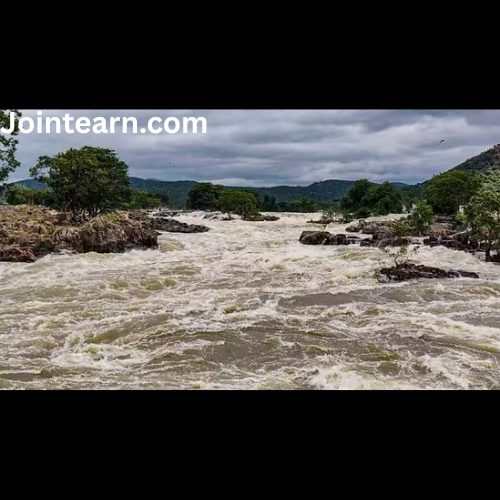
Odisha is bracing for potentially severe weather as a deep depression over the Bay of Bengal shows signs of intensifying into a cyclonic storm, which, if named, will be called Cyclone Montha—the designation submitted by Thailand under international naming conventions. The India Meteorological Department (IMD) has issued a series of alerts and time-wise forecasts as the system gradually advances toward India’s east coast, prompting the state government to place all districts on high alert and activate precautionary measures.
The depression began forming over the Bay of Bengal earlier this week and intensified into a deep depression by Sunday morning. According to the IMD, the system is likely to move west-northwestwards and could further strengthen into a cyclonic storm over the southwest and adjoining west-central Bay of Bengal within 24 hours. Authorities anticipate that by the evening or night of October 28, the storm could cross the Andhra Pradesh coast between Machilipatnam and Kalingapatnam, near Kakinada, as a severe cyclonic storm, with maximum sustained winds expected to reach 90-100 kmph and gusts up to 110 kmph.
IMD Forecast: Time and Intensity
The IMD has provided a detailed time-wise and intensity-based forecast of the system’s progression:
| Date/Time (IST) | Position (Lat°N / Long°E) | Maximum Sustained Surface Wind Speed (kmph) | Cyclonic Disturbance Category |
|---|---|---|---|
| Oct 25, 05:30 AM | 10.8 / 89.0 | 40-50 gusting to 60 | Depression |
| Oct 25, 11:30 AM | 10.8 / 88.6 | 40-50 gusting to 60 | Depression |
| Oct 25, 17:30 PM | 10.8 / 88.1 | 45-55 gusting to 65 | Depression |
| Oct 25, 23:30 PM | 10.9 / 87.6 | 50-60 gusting to 70 | Deep Depression |
| Oct 26, 05:30 AM | 11.2 / 86.9 | 55-65 gusting to 75 | Deep Depression |
| Oct 26, 17:30 PM | 11.6 / 86.1 | 60-70 gusting to 80 | Cyclonic Storm |
| Oct 27, 05:30 AM | 12.3 / 85.1 | 70-80 gusting to 90 | Cyclonic Storm |
| Oct 27, 17:30 PM | 13.1 / 84.4 | 80-90 gusting to 100 | Cyclonic Storm |
| Oct 28, 05:30 AM | 14.7 / 83.6 | 90-100 gusting to 110 | Severe Cyclonic Storm |
The IMD has emphasized that the system could intensify further, and the projected path indicates that Odisha could experience significant wind and rainfall impact over the coming days.
Alerts Issued and Precautionary Measures
In anticipation of the worsening weather, the Odisha government has issued a multi-tiered alert system for the state. On Sunday, no warnings were issued, but authorities have prepared for heavy rainfall, strong winds, and potential flooding in low-lying areas.
- October 27: The IMD has issued an orange alert, signaling heavy to very heavy rainfall at isolated places in Malkangiri, Koraput, Nawarangpur, Kalahandi, Rayagada, Gajapati, Ganjam, Kandhamal, and Jagatsinghpur districts. A yellow alert has also been issued for districts including Nuapada, Bolangir, Boudh, Nayagarh, Khurda, Puri, Cuttack, Kendrapada, and Jagatsinghpur.
- October 28: A red alert has been declared for scattered heavy to very heavy rain, with extremely heavy rainfall in Malkangiri, Koraput, Rayagada, Gajapati, and Ganjam. Orange alerts are in place for Nawarangpur, Kalahandi, Kandhamal, Nayagarh, Khurda, and Puri. Yellow alerts have been issued for Nuapada, Bolangir, Sonepur, Boudh, Angul, Dhenkanal, Cuttack, Khurda, Puri, Jagatsinghpur, Kendrapada, Jajpur, Keonjhar, Bhadrak, Balasore, and Mayurbhanj.
- October 29: Red alerts remain for Malkangiri, Koraput, Nawarangpur, Kalahandi, and Rayagada, with scattered heavy to very heavy rain and isolated extremely heavy downpours. Orange and yellow alerts continue for multiple other districts depending on their vulnerability.
The IMD has warned that the sea conditions along the Odisha coast and adjoining Bay of Bengal would remain “rough to very rough” from the evening of October 26 to the evening of October 27. Conditions are expected to worsen from the morning of October 28 until the afternoon of October 29 before gradually improving. Fishermen have been advised not to venture into the Southwest and central Bay of Bengal until October 29 and are urged to return immediately if they are already at sea.
Odisha Government Response
Odisha’s Revenue and Disaster Management Minister Suresh Pujari has stated that all 30 districts of the state are on high alert. He confirmed that men and machinery are ready for rescue and relief operations. District Collectors have been instructed to evacuate residents from low-lying areas and regions prone to strong winds ahead of the heavy rainfall.
Fifteen districts in Odisha’s coastal and southern regions are expected to bear the brunt of the cyclone’s impact. In anticipation of emergency operations, leaves of government employees in these areas have been cancelled. Authorities are also coordinating with local administrations to ensure that adequate shelters and relief centers are prepared for potential evacuations.
Risk Areas and Expected Impact
Coastal districts, particularly those along the Bay of Bengal, are at heightened risk due to storm surges, heavy rainfall, and strong winds. In addition to the immediate danger of floods and waterlogging, the IMD has cautioned that disruption of power, communication lines, and damage to infrastructure is possible. Citizens in vulnerable areas are advised to remain indoors, avoid travel, and follow government advisories closely.
The storm’s predicted trajectory could also affect the southern districts, bringing isolated heavy rainfall and wind disturbances. Local authorities have been instructed to clear drainage systems, monitor rivers and reservoirs, and ensure that emergency teams are in place to respond to any distress calls promptly.
Public Advisory and Safety Measures
Residents are urged to remain alert, secure loose objects, and avoid traveling in low-lying or flood-prone areas. Schools, colleges, and offices in high-risk regions may face temporary closures if the storm intensifies as forecasted. Citizens are advised to keep emergency contact numbers handy, maintain stock of essential supplies, and follow updates from the IMD and local administration for real-time instructions.
The state government has also requested private agencies, NGOs, and civil society organizations to support the administration in disseminating information, assisting in evacuation, and providing relief to affected communities.
Preparations for Cyclone Montha
With the deep depression likely to escalate into a severe cyclonic storm, Odisha is implementing comprehensive disaster preparedness measures. These include:
- Deployment of rescue teams, boats, and medical aid units in vulnerable districts.
- Setting up temporary shelters equipped with food, water, and medical supplies.
- Evacuation plans for coastal and flood-prone villages.
- Coordination with the Indian Coast Guard and Navy for emergency assistance at sea.
- Continuous monitoring of the storm’s movement and intensity by the IMD, with updates shared through media and social platforms.
Conclusion
Odisha is on high alert as the Bay of Bengal depression intensifies and threatens to develop into Cyclone Montha. Authorities have issued multi-tiered alerts, mobilized resources for rescue and relief operations, and instructed citizens to take necessary precautions. With forecasts predicting severe winds, heavy rainfall, and rough sea conditions, proactive measures, timely evacuations, and community awareness will be crucial to minimizing damage and ensuring public safety.
Residents are advised to stay updated with official IMD advisories, avoid unnecessary travel, and adhere strictly to government instructions until the cyclone passes. The coming days will be critical for Odisha, as preparation and vigilance remain the state’s best defense against Cyclone Montha’s potential impact.


Leave a Reply